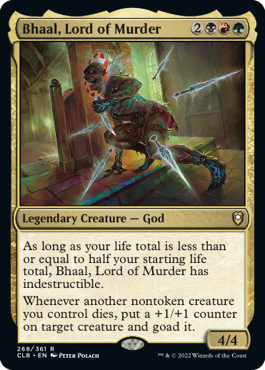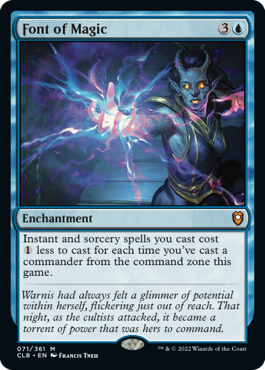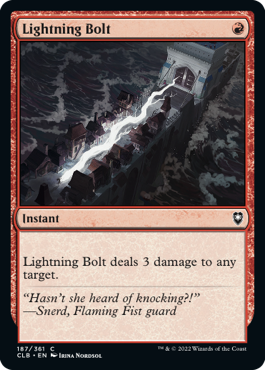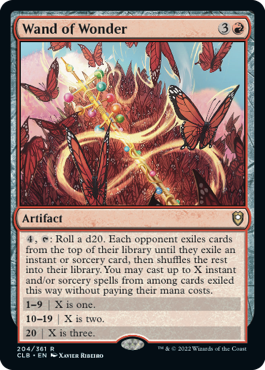Going Baldur's Gate, Part 2
Last week, I started telling card-by-card design stories from Commander Legends: Battle for Baldur's Gate. I have more stories to tell, so I'm continuing those today.
Bhaal, Lord of Murder

First up is Bhaal, Lord of Murder, one of three Gods in the set known in Dungeons & Dragons, along with Bane and Myrkul, as the Dead Three. They are the primary antagonists in the Baldur's Gate games.
Kresh, the Blood-Braided (version #0)
2BRG
Legendary Creature — Human Warrior
3/3
Whenever another creature dies, you may put X +1/+1 counters on Kresh, the Blood-Braided, where X is that creature's power.
This is a reprint from Shards of Alara. My best guess as to why this was in the slot is that they were playtesting and needed some rares to fill out the file for the playtest. It's very common when you haven't designed a card yet to grab a reprint that's in a similar space. Kresh was just a good placeholder for a rare black-red-green legendary creature.
Jan Itor (version #1)
1BRG
Legendary Creature — Human Warrior
4/4
Haste
T, Sacrifice X creatures: Create X Treasure tokens.
Whenever you cast a creature spell, if mana from a Treasure was spent to cast it, that creature enters the battlefield with an additional +1/+1 counter on it for each mana from a Treasure that was spent to cast that spell.
When doing a set with a lot of existing characters, you often design cards top-down (create the design to match the flavor of the character), but sometimes you just make an interesting mechanical design and see if you can find an appropriate creature to match. D&D has a lot of characters who interact with Treasure, so I assume the thought was that they could find a character if the card ended up playing well.
Bhaal, Lord of Murder (version #2)
3BRG
Legendary Creature — God
5/5
This spell costs 1 less to cast for each black, red, and/or green creature you control.
Bhaalspawn are goaded.
At the beginning of each player's upkeep, that player creates a 2/2 red Bhaalspawn creature token with haste.
Whenever a Bhaalspawn dies, its controller loses 2 life.
It seems they decided pretty early that this was going to be a top-down Bhaal design. This version gave him a cost-reduction ability and repeatable creature token creation. Unlike traditional creature token making, this card gives tokens to all players, but those creatures come with some drawbacks. The end result was a pretty chaotic card (and Bhaal's a pretty chaotic fellow).
Bhaal, Lord of Murder (version #3)
2BRG
Legendary Creature — God
6/3
At the beginning of your combat step, goad target creature. It can't block until your next turn.
Whenever a goaded creature dies, create a 3/1 black Bhaalspawn creature token.
The next version kept some elements of the previous but is mostly a new design. It kept the larger feel of Bhaal creating chaos. As you will see with each iteration, the mana cost and power/toughness kept getting tweaked.
Bhaal, Lord of Murder (version #4)
4BRG
Legendary Creature — God
6/3
CARDNAME has indestructible as long as there is a black creature card, a red creature card, and a green creature card in your graveyard.
All creatures have vigilance, double strike, and must attack each turn if able.
Magic has made several Gods over the years, and one of the most common traits between them (although not all of them) is being indestructible. Indestructible creatures have proven hard to balance, though, so we tend to make the indestructability situational. They're indestructible some of the time. This version is the first stab at trying to find an appropriate conditional indestructibility. The second ability is just a new stab at chaos making that result in a lot of creatures dying.
While the design team was still trying to figure out how to capture Bhaal, they were willing to commit to it being Bhaal so the art director could get art made for it.
Art description:
SETTING: *PENTAGON*
COLOR: Legendary creature associated with black, red, and green mana
LOCATION: We are behind the throne in a stately vaulted throne room with high windows accented with silver, green, and red (we see the back of the throne).
ACTION: Design a FERAL CORPSE GOD who crouches menacingly behind the throne as if he's about to spring from hiding. Two rings of floating objects circle him in midair: 1) oversized, perfect droplets of blood which encircle his head vertically to create an effect like the symbol in the reference, and 2) six bone daggers which surround him horizontally. His body looks long dead and hairless, and it has lacerations which ooze black ichor (not gory, but gross). His veins and arteries protrude from his skin irregularly (including on his face) but are made of solid silver. Somewhere on his person is a blood-red handkerchief. He might wield a curved bone dagger like the floating ones—all of the daggers should be ready to strike.
FOCUS: The corpse god
MOOD: Upsetting, terrifying, murderous. Almost frothing.
In a normal set, there's work to be done to understand who the character is, but in a licensed product, the characters already exist, so we have the ability to hit on a lot of tiny details about the character.
Bhaal, Lord of Murder (version #5)
2BRG
Legendary Creature — God
5/3
CARDNAME can't attack or block unless black, red, and green are among the colors of creature cards in your graveyard.
All creatures attack each combat if able.
Whenever a creature attacks the player with the most life, double its power until end of turn.
The design team questioned whether Bhaal needed to have indestructability and tried something different. Instead of giving you a bonus for having the correct colors of creatures in your graveyard, it became a drawback if you didn't. The card still forced creatures to attack but now encouraged attacking the person with the most life. Commander design has enjoyed playing in spaces that encourage attacking the player in the strongest position rather than the weakest.
Bhaal, Lord of Murder (version #6)
3BRG
Legendary Creature — God
8/5
Bhaal, Lord of Murder doesn't untap during your untap step. At the beginning of your upkeep, you may sacrifice a creature. If you do, untap Bhaal.
Whenever another creature you control dies, put a +1/+1 counter on target creature and goad it.
The next version got a bit bigger but tied it to a new drawback. The design team tried another take on the chaos-inducing flavor of Bhaal, this time finding the effect that will make the printed card. The first ability will go back to an indestructible variant, one that ended up going on all of the Dead Three. Finally, the mana value and power/toughness are tweaked yet again. It took a lot of exploration, but the design team finally found the right mix of abilities to make Bhaal feel correct.
Font of Magic

Next, we'll talk about the design of a cool new enchantment, a blue mythic rare called Font of Magic. Font of Magic is an ability connected to sorcerers in D&D.
Sphinx of the Second Sun (version #0)
6UU
Creature — Sphinx
Flying
At the beginning of your postcombat main phase, there is an additional beginning phase after this phase. <i>(The beginning phase includes the untap, upkeep, and draw steps.)</i>
As with Bhaal, the card slot started as a reprint for early playtesting. This tells me that the initial thought was that this would be a legendary creature slot. While we are quite exact with our creature percentages at common, mythic rare and, to a lesser extent, rare have more flexibility in creature percentages as they have far less impact on the as-fan.
Big Finish (version #1)
1U
Instant
Until end of turn, you may cast sorcery spells as though they had flash. Whenever you cast a sorcery spell this turn, copy it. You may choose new targets for the copy.
The first attempt at the design for this slot made a narrow but potentially powerful spell. Mythic rare instants are very hard to design, so I appreciate what this card was trying to do.
Font of Magic (version #2)
1U
Enchantment
When CARDNAME enters the battlefield, pick up the Torch.
As long as you have the Torch, you may cast spells as though they had flash. Whenever you cast an instant or sorcery spell, if you have the Torch, you may copy it. You may choose new targets for the copy.
The next version of this spell took the essence of the spell but changed its execution. For starters, it turned it from an instant into an enchantment. This allowed the effect to last longer than a single turn. It also broadened the scope of the effect in two ways. One, it granted flash to all card types, and two, it copied instants as well as sorceries. That tells me playtesting found the previous version a little too narrow. I should also point out that this was the iteration where the spell became Font of Magic. Being that the last version didn't have the name, I think someone on the design team saw an opportunity with this card to capture an element of D&D.
The biggest change is the introduction of picking up the Torch, the early name for taking the initiative. The designers wanted the card to have more gameplay but still wanted to have some limitations on how often you could use it, so they tied it to the initiative. For all intents and purposes, it was granting an additional ability to the initiative for you. It was at this point that the card went out to the artist.
Art Description:
*** EXTENDED-ART TEMPLATE WITH LIVE AREA OF STANDARD ASPECT RATIO ***
SETTING: *PENTAGON*
COLOR: Spell associated with blue mana
LOCATION: The center of a rope bridge across an underground chasm
ACTION: Please show a BEAUTIFUL EXPLOSION of MAGICAL pink, light blue, and white streaks of ENERGY which explode in two SYMMETRICAL bursts from the hands of a muscly tiefling SORCERER woman with a masculine hairstyle (see pp. 91–93 for tieflings and 155–156 for sorcerers). She looks surprised and amazed at the magic she's creating.
FOCUS: The eruption of magic
MOOD: Awe and power
The design team hadn't settled quite yet on what the card did, but they knew the top-down flavor they were trying to capture.
Font of Magic (version #3)
2U
Enchantment
When you cast an instant spell from your hand, you may cast target sorcery card from your graveyard. If you do, exile that spell as it resolves.
When you cast an sorcery spell from your hand, you may cast target instant card from your graveyard. If you do, exile that spell as it resolves.
This version was a big departure from the previous versions. It was still an enchantment that cared about instants and sorceries, but it had a completely different payout. Also, it's interesting that this version is really pushing for you to play an equal number of instants and sorceries. That's not a deck-building constraint we've done much before.
The final printed version is yet another departure, a sign that the team struggled a bit filling this slot. It's a good example of design constantly iterating to find the effect they're happiest with. The printed version still cares about instants and sorceries but is more about cost reduction and ties it to the Commander format, something we only tend to do in Commander products. As someone who's always watching out for future design space, I appreciate designs that could only be made in this set.
Lightning Bolt

Obviously, the blue one ended up being significantly better than the rest and was moved up to rare before the set released. Over the years, four of the five cards have fallen out of favor in premier sets.
Fists of Fire (version #1)
2R
Sorcery
Draw a card. Until end of turn, two target creatures each get +1/+0 for each card you've drawn this turn.
This common red slot started out as a combat enhancement (I won't say combat trick as it being a sorcery prevents surprise mid-combat). I assume this was trying to capture the flavor of a D&D feat called Fiery Fists.
Fists of Flame (version #2)
1R
Instant
Draw a card. Until end of turn, target creature gains trample and gets +1/+0 for each card you've drawn this turn.
The next version turned it into a combat trick by making it an instant. I'm not sure if this was tying into some larger theme that they were trying with red. Note that the "cantrip" comes first instead of last, as normal, to better interact with the other effect of the card.
Grapebullet (version #3)
R
Instant
CARDNAME deals X damage to any target, where X is the number of spells you cast this turn.
The next version shifts the card from being a combat trick to being a direct-damage spell. It's a niche design (meaning that it's potentially powerful, but only in a very specific slice of gameplay), so much so, that I'm surprised they put it at common. My best guess is that it was tying into one of the draft archetypes involving red.
Spellblaze (version #4)
1R
Instant
CARDNAME deals X damage to any target, where X is the number of instant cards, sorcery cards, or cards with an Adventure ability in your graveyard.
The design team decided they liked this being a direct-damage card but changed it to make it a bit more relevant to other aspects of the set. Normally, a card like this would just count instants and sorceries, but Adventures were in the set, so they looped that in as well. Another example of a design that couldn't be made outside of this set.
Spellblaze (version #5)
2R
Instant
CARDNAME deals 3 damage to target creature or planeswalker. If there are two or more noncreature, nonland cards in your graveyard, CARDNAME deals 5 damage instead.
The next version kept the spirit of the last version but simplified it a bit, so there's only two states. This new version included non-creature artifacts and enchantments but removed cards with an Adventure from the subset it cared about. Commander Legends: Battle for Baldur's Gate introduces Adventures on noncreature artifacts, so this card can care about those.
In the end, the design team decided that if they were going to make a red common direct-damage spell that deals 3 damage, why not just go with the classic D&D and Magic spell,
Art Description:
SETTING: *PENTAGON*
COLOR: Spell associated with red mana
LOCATION: Wyrm's Crossing, a bridge in the Outer City with a fortress on it (see reference)
ACTION: A SUPER-POWERFUL singular STROKE OF yellow-white LIGHTNING blasts out in a 100ft LINE atop the bridge toward the fortress. The lightning bolt comes from the outstretched hand of a young human sorcerer, who we likely won't see in much detail, but she's approaching the fortress from the shore to attack. See pp. 155–156 of the "Zebra" world guide for sorcerers if needed.
FOCUS: The lightning bolt
MOOD: BZAP!
NOTES: This card is a reprint. Its name is final.
Wand of Wonder

The final story of today is about the design of a beloved D&D item, the Wand of Wonder. It's a wand that has 22 different possible effects. Whenever you use it, you randomly get one of them. It's a very chaotic but fun weapon that many D&D players have had the fun of playing with, myself included. (Back in 2007, I did a Topical Blend article where I combined the topics of the ten best creature designs in Magic with Dungeons & Dragons. In it, I tell a bunch of stories from my D&D days, one of which features the Wand of Wonder.) The Wand of Wonder has inspired several designs over the years. Here are the two designs I know specifically started as a top-down Wand of Wonder,
Let's talk about how this Wand of Wonder was made.
Warstorm Merge (vesion #1)
4R
Enchantment
Whenever a creature with exactly two creature types enters the battlefield under your control, it deals X damage to any target, where X is the number of creatures in your megaparty. (Your megaparty is any number of creatures you control with unique pairs of creature types.)
This card didn't start as a Wand of Wonder or even as an artifact. It started as an enchantment that repeatedly did direct damage. Like Pact Weapon from last week, this slot started as a megaparty card. In this version, megaparty counted how many creatures you had with exactly two creature types that didn't in combination match any other creature. If you had multiples, you would count one of them toward your megaparty count.
Hot to Touch (version #2)
3R
Enchantment
When CARDNAME enters the battlefield, pick up the Torch. Whenever a creature with a Class enters the battlefield under your control, it deals X damage to any target, where X is the number of creatures with a unique Class you control.
The next version removed megaparty and added pick up the Torch (again, the early name for take the initiative). They made this version during a point where they were trying to define Class as certain subtype of creature types. It was still looking for variety, but now only looking at Classes.
Hot to Touch (version #3)
3R
Enchantment
When CARDNAME enters the battlefield, you take the initiative. Whenever an opponent takes the initiative, that player may have you draw two cards. If they don't, CARDNAME deals 4 damage to them.
This version stopped caring about creature types and instead leaned into affecting take the initiative. This version basically added a punisher effect (choose the first effect or take a bunch of damage). Because the opponent could decide, the first effect allowed for something outside of red's color pie, in this case, card drawing. The idea is that the punisher effect is chaotic, which fits red's flavor.
Rod of Wonder (version #4)
1R
Artifact
4, T: Roll a d20. Activate only as a sorcery.
1–9 | Exile cards from the top of your library until you exile an instant or sorcery card. You cast it without paying its mana cost if able.
10–19 | Do the same for each player's library.
20 | Instead exile cards until you reveal three instants and/or sorceries from each player's library.
This is where the card became Wand of Wander. (I'm not sure why it was called Rod of Wander.) As one would expect from the top-down flavor, the effect is random. To ensure many effects without having to create a lot of text, the card uses the top of the library as a randomizer and the source of the effects. This version isn't too far away from the printed version; they were trying to find the most elegant way to make the card work.
The big obstacle with making this version work was that having the text find the instant and sorcery spells and cast them can be quite wordy. The solution was making one big ability up front and just explaining how many times it happens when defining the various rolls. The spell also ended up costing a bit more. Finally, here is what the art director sent to the artist:
Art Direction:
*** EXTENDED-ART TEMPLATE WITH LIVE AREA OF STANDARD ASPECT RATIO ***
SETTING: *PENTAGON*
COLOR: Artifact associated with red mana
LOCATION: Amidst a huge cloud of fantastical red butterflies
ACTION: Please show a WAND OF WONDER (see reference), a gold and metal magical wand with many glowing spheres of different colors on it, out of which bursts radiant light of many colors that flows magically between the butterflies. Maybe the small spokes with spheres at the end, near the end of the wand, are in the midst of spinning wildly and producing the magical light. Maybe it looks like the butterflies are also magically emerging from the wand.
FOCUS: The wand
MOOD: An exciting and surprising magical artifact!
The reason there are so many butterflies in the art is that one of the effects creates a giant cloud (six hundred in Fifth Edition) of oversized butterflies, and it's sort of become an iconic effect for the Wand of Wonder.
"And They All Lived Happily Ever After"
That's all my stories for today. I hope you enjoyed them. As always, I'm eager to hear your feedback on the article, any of the cards I talked about, or on the set itself. You can email me or contact me through any of my social media accounts (Twitter, Tumblr, Instagram, and TikTok).
Join me next week when I examine the vision design handoff document for Commander Legends: Battle for Baldur's Gate.
Until then, may the cards create even more stories.

